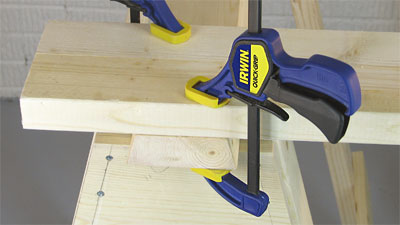Your cart is currently empty!

Woodworking Clamps

Clamps are an essential tool in every woodworker’s toolkit. They’re a great way to hold small parts or stabilize large parts during the glue-up process.
However, clamps come in a variety of types and sizes, so it’s important to choose the right ones for the project you’re working on.
C-clamp
The C-clamp is a type of clamp that holds two pieces of wood or metal together. This device is commonly used in carpentry and welding applications.
The frame of the C-clamp is typically made from metallic materials such as steel or cast iron. This makes them very durable and warp-resistant.
A C-clamp also contains a threaded screw that controls the movement of the adjustable jaw. The screw is usually ACME-shaped, which gives the clamp a stronger grip on the workpiece.
To close the jaws of the C-clamp, the handle is first rotated clockwise till the screw is tightened. Then the handle is turned anti-clockwise to open the jaws.
A C-clamp can hold many different types of materials. They are especially useful for holding workpieces together while they’re being glued.
Spring clamp
A spring clamp is a quick and easy tool that uses the pressure of a metal spring to clamp down two ends of a workpiece. These clamps are useful in fastening materials, gluing and cutting woodwork projects.
The jaws of the spring clamp have rubber pads that protect the material from damage. These clamps are one of the first types of woodworking tools that most woodworkers collect and often have multiple sizes in their collection.
The most common size of spring clamps is 6 inches in length. This size is perfect for helping glue wood, glass and other delicate items.
Parallel-jaw clamp
One of the most useful clamps for woodworking glue-ups and assemblies is the parallel-jaw clamp. They feature large jaws that stay parallel even under heavy pressure, which ensures square assembly and flat panel glue-ups.
Most parallel-jaw clamps have a fixed jaw on one end of the bar and a sliding jaw that travels along the bar. Typically, that sliding jaw slides uncontrollably and crashes into the fixed jaw when held vertically, but some models have a finger trigger below the handle that reliably engages the bar without backsliding.
Another advantage of these clamps is that they apply an evenly distributed amount of pressure to your workpieces, which helps reduce the risk of crushing or marring your boards. This can be particularly important when gluing up wide panels from narrower boards.
Some models also have removable bar pads, which are little brackets that sit on the clamp bar to help keep your workpiece stable. They also have replaceable jaw sleeves, which are nonmarring barriers that protect your workpiece from the hard jaws.
Bar clamp
A bar clamp is a tool that can be used to hold materials securely in place. It can be found in many different shapes and sizes.
These types of clamps are usually used when you need to join two pieces of wood together, such as for molding or bonding purposes. They are also used for securing larger items, such as doors or cabinets.
When using a bar clamp, it is important to use the right amount of pressure to ensure that both of the pieces are tightly held together. If too much pressure is applied, it may cause the material to break apart.
These type of clamps are a great way to secure large items. They also come with a wide variety of features, including adjustable jaws that can be widened and narrowed to suit the size of the workpiece.
by
Tags: